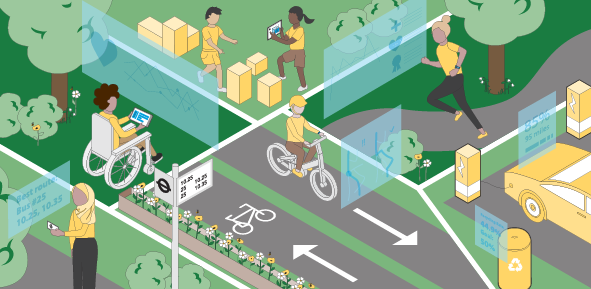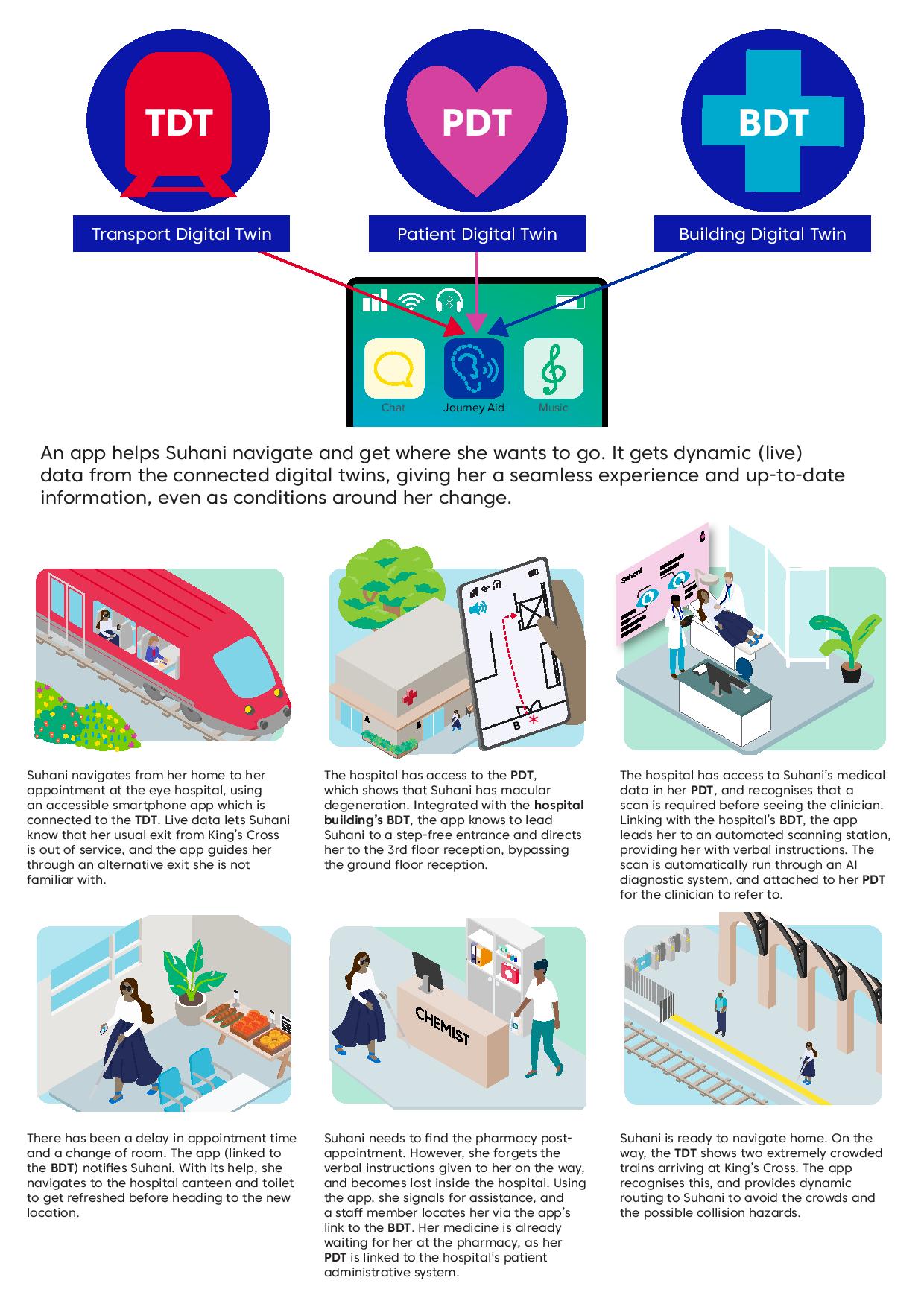
Plans for Oriel, a new hub for eyecare, have been in development since 2011. A design team was appointed in 2019, offering CDBB-funded researchers based at the University of Cambridge’s Judge Business School a timely opportunity to explore what designing a Hospital of the Future might mean.
The eyecare specialism presents an additional array of considerations, since such a facility must prioritise accessibility for patients with sight loss. The new hospital will host state-of-the-art technologies, including telemedicine, machine learning and AI technologies, capable of processing real-time data about medical care and the built environment. How might the hospital’s digital twin support and improve service users’ experience in this specific healthcare context? What does inclusive design look like for smart hospitals? How can clinicians, architects, managers, tech companies, and patients stimulate service transformation for the digital healthcare era?
Process
The study was intended to begin with a phase of ethnographic observation, with a researcher embedded in the service division of Moorfields’ design hub. The COVID-19 pandemic interrupted the original plan, but it also provided a remarkable opportunity to observe event-driven innovation and the rapid adoption and adaptation of digital technologies.
Researchers began by conducting a literature review of existing studies on smart hospitals and telemedicine, using this to develop a framework for telemedicine, service innovation and hospital design. Formal collaboration had already been established with Moorfields Innovation Hub, the base of the clinical team designing the new Smart Hospital, and an honorary NHS fellowship was arranged for the lead research associate.
Preliminary data collection on the service transition and digital transformation of Moorfields’ built environment was ready to begin when COVID-19 landed. The Innovation Hub was commandeered for pandemic response, and onsite observational ethnography had to be postponed. Unphased, researchers took the opportunity to conduct Zoom interviews and study how technology was being used by Moorfields to respond to the pandemic. The organisational frontline of service provision was undergoing rapid transformation. With multiple rounds of interviews, the researchers gathered rich data from the different stakeholder groups.
Meanwhile, the researchers were also learning from patterns of change at Sheba Medical Center, Tel Aviv. Clinicians there responded to the pandemic by isolating part of the hospital to handle COVID infections. Telemedicine helped bridge the distance between those in the COVID wards and those administering care and expertise from outside the COVID zone.
Researchers also initiated additional lines of enquiry, consulting some of the people who will use Oriel’s services about inclusive service design. This work was combined with investigations into cutting-edge technology to plan out a user journey:
Connecting with digital twins
The team engaged with technology start-ups to consider the navigation challenges of relocating a hospital that serves those with sight loss. The current set-up relies upon a green line painted on the pavement between Old Street Station and the hospital 3 minutes’ walk away. The new site is between 6 underground stations, lying around 13 minutes’ walk from Kings Cross railway station. The last half mile of the journey is freshly perilous. Could smartphone applications from WayMap and Navvis help patients find their way?
The concept of digital twins is new to these stakeholders. While the technology to guide people—whether by camera or by bouncing off WiFi and Bluetooth signals—is already with us, these technologies are still met by limitations such as the scale of data points needed to navigate reliably without camera information and the battery power needed to navigate with camera in hand. Thinking these challenges through during the design phase makes it easier to embed appropriate technology within and around the new hospital’s built environment.
Researchers co-created an infographic to illustrate how digital tools can support user access. As Karl Prince and colleagues have explained, the infographic follows Suhani as she navigates an appointment, highlighting how assistive technology and smartphones can work together to ease the process:
“In transit, at check-in, and beyond, Suhani is aided by interoperable, live data from various digital twins that seamlessly respond to changing circumstances. Though undetectable to Suhani, they help her meet her goal of safely and comfortably getting to her appointment. They also help her doctors deliver the best care possible. Doctors at the eye hospital rely on a wider ecosystem of digital twins (beyond their own building’s twin) to make sure this happens. Suhani’s successful journey to the hospital is vital to ensuring they can provide her with care."
So what?
The response to COVID and resulting use of new technology turned out to be a perfect case study of transition and innovation, in terms of the healthcare sector and for digital maturity more generally. Moorfields is the major centre for emergency eye care in London. How could it provide care when hospital attendance was not safe? The pandemic, and its urgency, vastly accelerated Moorfields’ progress in telemedicine.
Clinicians developed facilities for online consultation, providing 100,000 appointments in three months. While the process evolved rapidly and under pressure of pandemic-specific demands, virtual consultations continue as a component of eyecare at Moorfields, allowing an optional triage that mitigates excessive physical queues. The researchers interviewed clinicians and others involved in developing and delivering this service, regarded as an NHS success story.
Collaboration with the Digital Twin Hub has ensured findings were captured in a way that can be easily shared with industry and other interested stakeholders. The infographic mapping Suhani’s journey is matched by a white paper co-written with Moorfields’ clinicians, highlighting the role of digital twins and service innovation in designing the Hospital of the Future. The authors explain the importance of adopting “a service-oriented lens to complement and go beyond the typical view of digital twins as a technological tool”.
The benefits for patients are non-trivial. For the future hospital, appropriate use of assistive technology should reduce the time investment necessary to identify, follow, and potentially adapt, a new route. This, in turn, reduces stress and anxiety associated with navigating hospital appointments. Meanwhile, the review of recent advances to ophthalmic video consultations identified benefits including safer outcomes for staff and patients and reduced disruption to patients’ lives, as travel to and from such appointments was no longer required, and virtual queues allow waiting time to be used productively.
A second study focused on what enables innovation, offering a longitudinal analysis of different phases of capacity-building and response. The authors identify how change was enabled via the adoption of new technologies as a result of COVID-19, and reflect on what factors enable further service innovation through digitalisation, at Moorfields and elsewhere.
Moorfields’ was already a digitally mature (or maturing) organisation with forward-looking leadership. Research insights into the mix of practices and capabilities that led to a successful response in crisis, and feed into plans for the Smart Hospital of the Future, are relevant to those seeking to understand and work toward digital maturity in other organisations. All sectors can benefit from the lessons about leadership, levelling up capabilities, leveraging gains for further innovation, adapting to new contexts, taking stock of technological progress, and preparing for future-defining technology. (An associated white paper “Developing your digital maturity for competitive advantage” was released as a DT Hub exclusive. Members can access it here; registration is free.)
Parallel studies at Sheba Medical Center, Israel, have also been published (Oborn et al, 2021; Pilosof et al 2021), recording how technological strategies around the use of telemedicine enhanced patient and staff safety during the pandemic.
Industry impact
This project used a service lens to consider how clinicians, managers, patients and other stakeholders will interact with the Smart Hospital of the Future, with reference to the specific context of ophthalmic medicine and identifying benefits for telemedicine and AI in healthcare more broadly. As a result of the research, practitioners at Moorfields have fresh insight into how to deliver value in a new purpose-built smart eye hospital space. Emerging digital technologies and AI that will become core to Moorfields’ future hospital and services are already beginning to impact how the ophthalmic ecosystem is structured.
Smarter medicine
Smart Hospitals and smarter medicine will deliver benefits beyond the direct changes to healthcare services. During the COVID-19 pandemic Moorfield developed virtual clinics to safeguard the health and wellbeing of patients and staff. While telemedicine is not a new technology, the rapid use of virtual clinics for sight impaired patients, where historically face-to-face examination has been key, is radical. Integration of CDBB researchers throughout the pandemic meant it was possible to record change in unparalleled detail, and so to document what and how conditions enable innovation in service provision.
Navigation and resource deployment
Navigation tools can provide a gateway to inclusivity for a sight-impaired community and will be crucial to Moorfields patients who will need to travel to and navigate a new site served by a range of transport hubs. The researchers have highlighted the potential for existing technologies and apps to support patients to access services and appointments at Moorfields.
In future, Oriel visitors will be able to use their own hardware (smartphones) and integrated technology to ease the journey to and through the hospital. Making health services more accessible automatically benefits the health and wellbeing of service users. Digital twins benefit other hospital stakeholders too. For example, up-to-date information about resource availability from road closures to broken-down equipment can reduce the impact of problems arising, redirecting people and reallocating resources. Appointment issues can be anticipated, mitigating the impact of missed appointments. Patients can proactively select their preference between physical and virtual queues. Testing suites that guide the patient through scans and follow-up tests can release clinicians and healthcare workers to focus their attention on those in greatest need. The potential for efficiency and service improvements is immense.
Wider benefits
This research also aimed to generate important and transferrable learnings beyond the ophthalmic services setting. Researchers have provided guidance for other service-based organisations’ process of service transition and transformation, in shifting to the new digital built environment of the future. For example, the survey and discussion concerning how digital tools and technologies can enable (and disable) access to spaces are of interest beyond hospital stakeholders and the sight-impaired community. The research has advanced understanding of good practice in support of inclusive universal design and the potential role of digital twins for access.
Moorfields researchers conducted an additional study demonstrating that the increase of telemedicine mid-pandemic led to direct reduction in greenhouse emissions. Smart hospitals for the future should benefit the natural world and our environmental capital.
Innovation
This qualitative project aligned with the Construction Innovation Hub’s mission to improve the delivery, resilience, sustainability and performance of infrastructure and enhance quality of life for its users. Researchers witnessed an atypical pace of change, and were therefore able to document significant learning about organisational readiness and capacity for change. The beneficiaries of this insight extend far beyond the healthcare sector, even as they inform Smart Hospitals of the Future.
“Moorfields is in the process of digitally transforming its clinical services in readiness for a move to a new hospital in 2025. Working with Cambridge Digital Innovation and the CDBB has generated insight from stakeholders throughout the organisation, and especially those on the clinical frontline, to understand how this transformation will affect our future services, and to learn importantly from the rapid innovation of clinical services that the Covid-19 pandemic demanded.”
Peter Thomas, Director of Digital Medicine, Moorfields Eye Hospital
Collaborators
- Moorfields Eye Hospital
- Cambridge Judge Business School, University of Cambridge
- Cambridge Digital Innovation, Hughes Hall, Cambridge Judge Business School
- Warwick Business School, University of Warwick
- ARC Innovation at Sheba Medical Center, Israel
- WayMap
- NAvVIS

